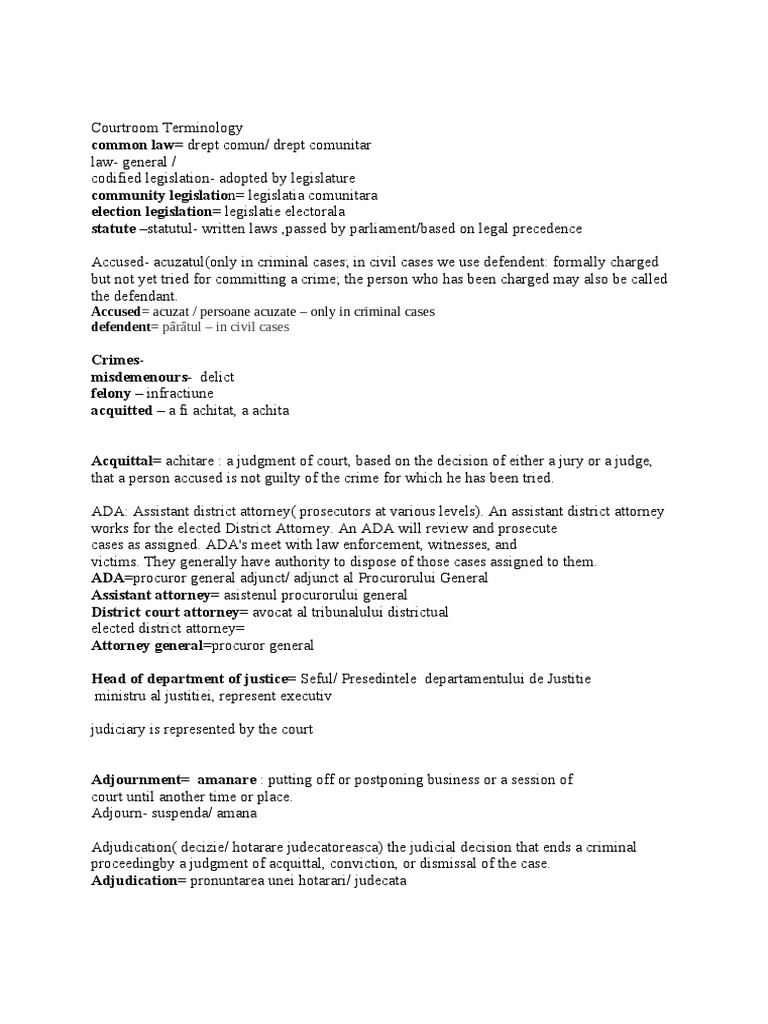The courtroom is often portrayed dramatically in films and television shows, with lawyers dramatically presenting their cases, witnesses taking the stand, and jurors deliberating intensely. However, beneath this sensationalized facade lies a world of precise terminology that serves as the backbone of legal proceedings. Understanding courtroom terminology is more than just learning new words; it is an invitation to unravel the complexities of justice, a journey into the very heart of how trials unfold. Through a comprehensive exploration of the language employed in the courtroom, we can glean insights that promise a shift in perspective and pique curiosity about the enigmatic world of law.
At the core of courtroom terminology are the key players. Familiarizing oneself with these roles can demystify much of the proceedings. The **judge**, often adorned in a black robe, stands as the arbiter of justice, wielding the gavel to maintain order and ensure that the trial progresses fairly. Their decisions shape the outcome of cases, guiding jurors and influencing the direction of legal arguments.
Next, we encounter the **prosecutor**, who represents the state or the government in a criminal case, tasked with proving the defendant’s guilt beyond a reasonable doubt. The prosecutor’s role is as much about presenting evidence as it is about negotiating pleas, which leads us to the **defense attorney**—the protector of the accused’s rights, striving to construct a robust defense against the accusations. Understanding the conflicting objectives of the prosecutor and defense attorney illuminates the adversarial nature of trials.
As the trial progresses, various proceedings unfold, each encapsulated in its own terminology. For instance, the **opening statement** marks the commencement of the trial, where both sides outline their cases to jurors. This moment sets the stage for the drama to come, where narratives clash before the watchful eye of the judge and jury.
Equally pivotal is the **examination-in-chief**, where witnesses called by the prosecution or defense provide testimony to support their respective cases. Following this, the opposing side engages in **cross-examination**, a strategic interrogation intended to challenge the credibility of the witness and enhance the questioning party’s argument. This interplay of questions and responses reveals not only the strengths and weaknesses of a case but also the art of persuasion that defines courtroom drama.
Evidence serves as the lifeblood of any trial, and understanding its classification is integral to grasping courtroom dynamics. The two primary categories are **testimonial evidence**, which encompasses statements made by witnesses, and **physical evidence**, encompassing tangible items like documents, photographs, or weaponry presented during the trial. Further complicating matters is the concept of **hearsay**, which refers to statements made outside of the courtroom that are not permissible as evidence unless they meet specific legal criteria. Hearsay rules dictate the quality and credibility of evidence, shaping legal arguments dramatically.
As the trial unfolds, jurors engage in a process that may seem enigmatic to outsiders. Their role is often minimized, yet it bears immense weight. Jury instructions, crafted by the judge, guide jurors on the pertinent legal standards and considerations they must adhere to while deliberating. A pivotal component of this is the phrase **beyond a reasonable doubt**, a legal standard that emphasizes the high level of certainty required to convict in criminal cases. The intricacies of the jury process highlight the delicate balance of justice and serve as a reminder of the community’s participation in moral and legal judgment.
In civil cases, distinct terminology arises, augmenting our understanding of legal processes. Consider the term **plaintiff**, the party who initiates a lawsuit, seeking redress for perceived harm. Conversely, the **defendant** is the individual or entity being accused of wrongdoing. Both sides navigate the nuances of civil litigation, where the emphasis is often on the preponderance of evidence—a more relaxed standard than that of criminal trials, allowing for a verdict based on the greater weight of evidence.
The **settlement** process is an alternative route within civil cases, wherein parties may decide to resolve their disputes outside of court, thereby sidestepping the unpredictability of a jury trial. Here, terms like **mediation** and **arbitration** play crucial roles, offering avenues for negotiation that can lead to mutually agreeable outcomes without the need for a formal trial. This burgeoning trend emphasizes the dynamic nature of legal resolution, often favoring efficiency over litigation.
As we traverse the landscape of courtroom terminology, it becomes evident that language shapes the very fabric of legal proceedings. The terms we encounter offer not only insight into courtroom protocols but also reflect broader themes of justice, morality, and societal norms. Through every case, the interplay of words and actions reveals the complexities of human experience and the stringent measures taken to uphold justice.
Ultimately, delving into courtroom terminology fosters a nuanced understanding of the legal system, urging us to reconsider preconceived notions about trials and justice. As we analyze these terms and their implications, we unravel the intricate dance of law and humanity—a wonderous journey that continues to captivate and enlighten.
